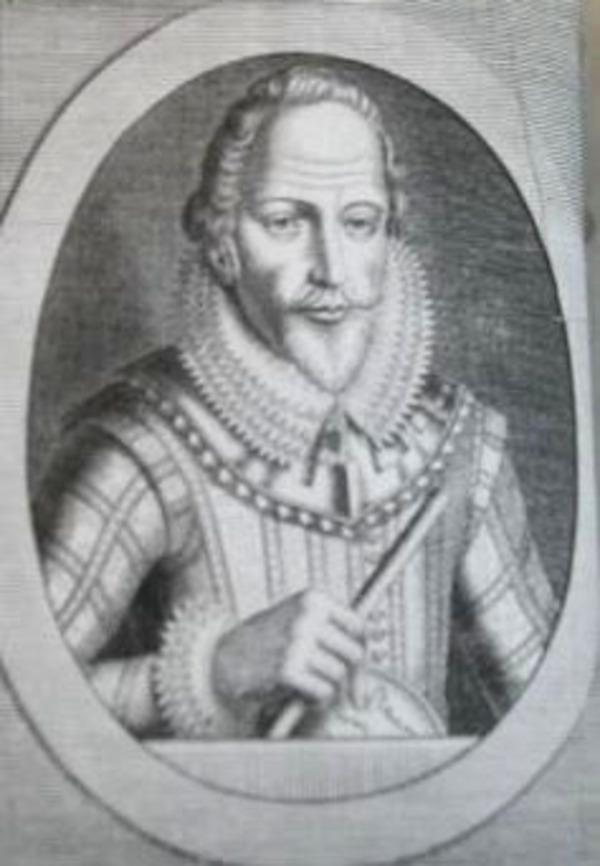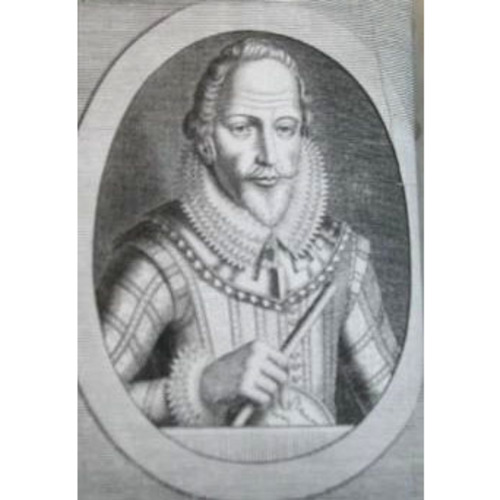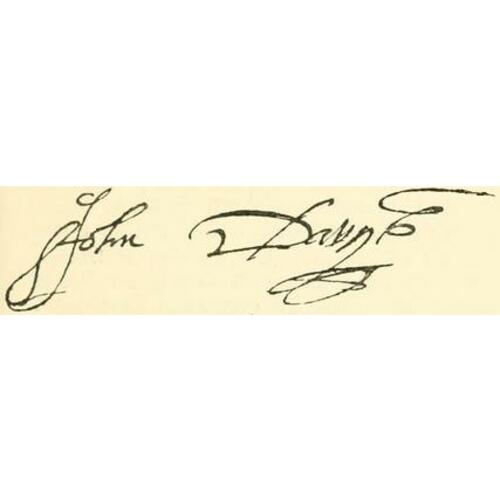
Source: Link
DAVIS (Davys), JOHN, navigator and explorer, discoverer of Davis Strait and the Falkland Islands, compiler of first Sailing Directions for the East Indies; b. 1550? on a small freehold at Sandridge near Dartmouth, Devon; married 29 Sept. 1582, to Faith Fulford, daughter of Sir John Fulford, by whom he had a daughter and four sons, three of whom survived him; d. 27 Dec. 1605 off Bintang Island, East Indies.
His childhood neighbours and lifelong friends were Humphrey and Adrian Gilbert and their younger half-brother, Walter Raleigh. Nothing is known of his early life, but his writings and his later friendships with the outstanding English mathematicians and cartographers of his day suggest he had at least a grammer school education, and certainly, by 1579 he was already highly regarded as a seaman and navigator.
Like many of his contemporaries, he was convinced of the existence of a northwest passage; his great ambition was to discover it and thus provide English commerce with a direct route to the Indies free from Spanish or Portuguese interference. By 1585 his friends had succeeded in persuading the queen’s secretary, Sir Francis Walsingham, to lend his patronage to such a voyage of discovery; ships and money had been provided by wealthy merchants of London and Devon, and Davis was placed in command. He sailed from Dartmouth 7 June, 1585, with the Sunneshine of London (50 tons) and the Mooneshine of Dartmouth (35 tons) – which Davis persistently called the Moonelight – and returned 30 September. He had reached Greenland, whose existence had been forgotten by most Europeans since contact with its Norse colonies had been lost in the 13th century, and, after crossing what was subsequently named Davis Strait, he had made landfall on the east Baffin coast in Exeter Sound at about 66°4´N He had not found the passage, but was now confident it lay either west up Cumberland Gulf (now Sound) or farther north up Davis Strait.
On 7 May 1586, Davis set out on his second arctic voyage. In addition to the two original ships he had also the Mermayde (120 tons) and a pinnace, the North Starre (10 tons). The Sunneshine and the North Starre, detached to search for a “Northward” passage between Greenland and Iceland, were turned back by ice, and the North Starre was lost in a storm. The Mermayde and the Mooneshine continued on to Davis Strait where conditions were less favourable than in the previous year. The Mermayde proved unwieldy in the ice and was finally sent home. Crossing to the west side of the strait, the Mooneshine continued alone until stopped by ice at roughly 67°N Standing well off shore because of the wind, Davis sailed south to about 54°30´N (Hamilton Inlet) where he replenished his food supplies with abundant catches of cod. He returned home 14th October.
Davis sailed again 19 May 1587. This time the Sunneshine and the bark, Elizabeth of Dartmouth, were to engage in cod-fishing while Davis, in the 20-ton pinnace, Ellen (Helene) of London, continued his explorations. Conditions along the west Greenland coast were exceptionally favourable and he reached 72°92´N through ice-free waters before stiff winds forced him to alter course. Here, at his farthest north, he named a high cliff “Sanderson, his Hope” (now Hope Sanderson) in honour of his chief backer, William Sanderson, wealthy merchant of London. He then sailed west until further progress was blocked by the ice-stream of the Canadian current. He turned south down the Baffin coast, explored again Cumberland “Gulf,” and noted the entrances to Lord Lumley’s Inlet (now Frobisher Bay) and Hudson Strait which he described as a “furious overfall.” He named Cape Chudleigh (now Chidley), its southeastern limit, entered the Labrador fiord which still bears his name (Davis Inlet) and finally reached the vicinity of Hamilton Inlet. He returned home 15 September, having successfully navigated his tiny vessel through more than 20° of arctic waters. He had charted long stretches of the Greenland, Baffin, and Labrador coasts, had made careful observations of ice conditions, terrain, rock formations, weather, vegetation, and animal life. His description of the Eskimos is one of the earliest, and certainly one of the most accurate and sympathetic accounts of their habits of life. His “Traverse book” of this third voyage became the model on which ships’ logs have since been patterned. Davis’s original charts of these voyages have been lost, but the records of his discoveries were recorded on the maps of the period published after his return, especially the great map of the world (1598–1600) by his friend, the mathematician, Edward Wright, and the famous Molyneux globe (1592). It is, in fact, believed that it was probably Davis who introduced Molyneux to Sanderson, their mutual patron.
Never again was he to explore the Arctic. English energies were now absorbed in the struggle with Spain and, with the death of Walsingham in 1590, “the voyage was friendless.” Davis, however, convinced that the discovery of this northwest passage would contribute to the growth of England’s trade and thus to her national greatness, endeavoured to continue the search. In 1591 he joined the expedition of Thomas Cavendish who was attempting his second circumnavigation of the globe. It was agreed that once the Straits of Magellan were cleared, Davis and his ship would be released to continue exploration up the “backe side of America” in search of the western entrance of the passage. The expedition was a disastrous failure, its only achievement being Davis’s discovery of the Falkland Islands. In 1595 he published his treatise, The worldes hydrographical discription, but this effort to gain support for the search so dear to his heart proved fruitless.
From 1598 to 1600 he served with distinction as pilot to the second Dutch expedition to the Indies, and on his return to London was appointed chief pilot to the highly successful first expedition of the East India Company. He returned home September 1603.
In December 1604, as pilot to Sir Edward Michelborne, he sailed aboard the Tiger (240 tons) on his third Indies voyage during which he charted the west coast of Sumatra and compiled the first known “Sailing directions” of the area. Off the east coast of Malaya the Tiger took a Japanese pirate ship in custody and, on 27 Dec. 1605, during a search of this ship, the pirates broke loose, killing Davis as their first victim.
Davis’s life as a sailor and explorer was dedicated to the service of his country and the science of navigation in the best tradition of Elizabethan seamanship. Although during the wars with Spain he served in the naval campaigns, he was essentially a man of peaceful pursuits and quiet humour, highly regarded by his colleagues and crews for his fine character and outstanding competence, his patient, sympathetic understanding, his measured judgments, and his ability to command. He was scholarly in his approach to the problems of navigation and seamanship and his Seaman’s secrets (1599), which for many years remained the mariner’s handbook of practical navigation, was published in order to share with fellow mariners the knowledge he had acquired in a lifetime of intelligent observation and experience at sea. He invented the backstaff, or Davis quadrant, which remained the approved instrument for determining latitude until the introduction of the reflecting quadrant in 1731. His treatise The worldes hydrographical discription (1595) provided a masterly summary of the geographical knowledge of his time, particularly in relation to the northwest passage. It has been rightly said of him that, in his arctic discoveries, he lighted Henry Hudson into his strait and Baffin into his bay and indicated to Hans Egede the scene of his Greenland labours.
Most of the original accounts of Davis’s voyages, as well as The worldes hydrographical discription (London, 1595) are published in vols. III and IV of Hakluyt’s collection of the early voyages, travels and discoveries of the English nation [ed. R. H. Evans] (5v., London, 1809–12), and in A selection of curious, rare and early voyages and histories of interesting discoveries, chiefly published by Hakluyt, or at his suggestion, but not included in his . . . compilation, to which, to Purchas, and other general collections, this is intended as a supplement [ed. R. H. Evans] (London, 1812). See also: Hakluyt, Principal navigations (1903–5), VII. The account of his last voyage and his death, written it is thought by Michelborne himself, is found in Purchas, Pilgrimes (1905–7), II, 347–66. There are also two excellent biographies: The voyages and works of John Davis, the navigator by A. H. Markham (Hakluyt Soc., 1st ser., LIX, 1880), which also contains a reprint of Seaman’s secrets (“Newly corrected by the Author,” London, 1599) and C. R. Markham, A life of John Davis, the navigator, 1550–1605, discoverer of Davis Straits (London, 1889). See also Oleson, Early voyages, 77, 88, 156–60.
Cite This Article
Margaret Montgomery Larnder, “DAVIS (Davys), JOHN (d. 1605),” in Dictionary of Canadian Biography, vol. 1, University of Toronto/Université Laval, 2003–, accessed April 5, 2025, https://www.biographi.ca/en/bio/davis_john_1605_1E.html.
The citation above shows the format for footnotes and endnotes according to the Chicago manual of style (16th edition). Information to be used in other citation formats:
| Permalink: | https://www.biographi.ca/en/bio/davis_john_1605_1E.html |
| Author of Article: | Margaret Montgomery Larnder |
| Title of Article: | DAVIS (Davys), JOHN (d. 1605) |
| Publication Name: | Dictionary of Canadian Biography, vol. 1 |
| Publisher: | University of Toronto/Université Laval |
| Year of publication: | 1966 |
| Year of revision: | 1979 |
| Access Date: | April 5, 2025 |




